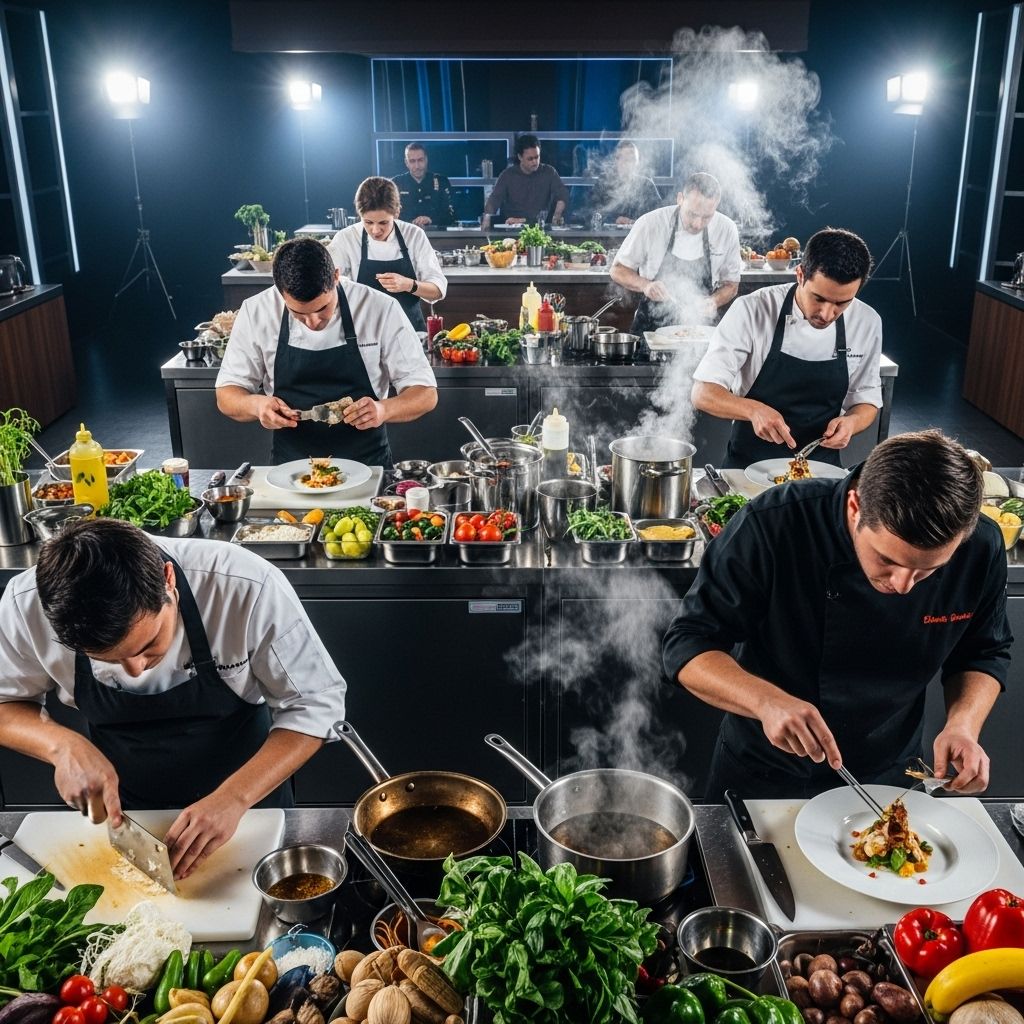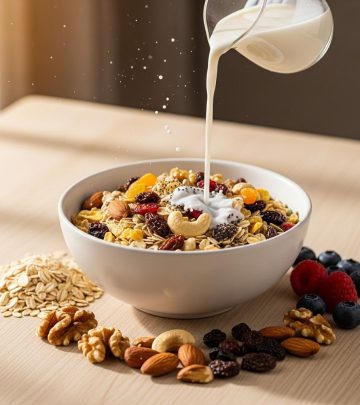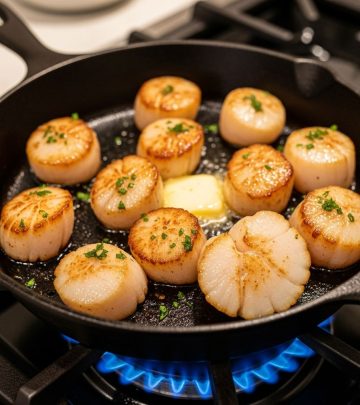Chopped: Inside the High-Stakes World of Food Network’s Intense Culinary Competition
Discover how Chopped tests chefs’ skills, stamina, and creativity with relentless mystery basket challenges and strict competition rules.

Chopped: The Ultimate Culinary Showdown
Chopped stands as one of the Food Network’s longest-running and most iconic cooking competitions. Every episode draws viewers into a relentless kitchen battle where professional chefs—and sometimes talented amateurs—are pitted against the clock, unpredictable ingredients, and each other for a chance at culinary glory and a $10,000 prize.
What Is Chopped and Why Has It Endured?
Since its debut, Chopped has captivated audiences by combining suspense, ingenuity, and the raw excitement of professional cooking. Four contestants enter each episode, facing three timed rounds where they must create appetizer, entrée, and dessert dishes featuring compulsory mystery basket ingredients. After each round, one chef is eliminated—or ”chopped”—until a single winner remains. The show connects both to passionate foodies and casual viewers by keeping the focus squarely on the food, the skill, and the improvisational ingenuity it takes to succeed.
The Structure of a Chopped Episode
Each episode of Chopped unfolds over three high-pressure rounds:
- Appetizer Round (20 or 30 minutes): The chefs must create a starter with four surprise basket ingredients plus communal pantry and fridge items.
- Entrée Round (30 minutes): The remaining three chefs tackle new basket components for the main course.
- Dessert Round (30 minutes): The final two competitors must make a dessert, once again featuring challenging mystery items.
Fast pacing, an ever-present countdown, and the looming chopping block create a tense atmosphere. The panel of three judges, featuring acclaimed chefs and food personalities, evaluate each dish based on presentation, creativity, and taste.
How to Become a Contestant: The Rigorous Selection Process
Not just anyone can compete on Chopped. The application and audition process is designed to select the most compelling, skilled, and resilient cooks for television’s toughest kitchen.
- Online Application: Prospective contestants complete a detailed application, highlighting their career trajectory, culinary skills, and personal story.
- On-Camera Interview: Selected applicants are invited for an on-camera audition to showcase their personality, cooking chops, and ability to handle pressure.
- Eligibility Requirements: Most episodes require U.S. citizenship and professional culinary experience—though special installments have featured talented amateurs like grandmothers or firefighters.
- Personal Story: Producers want chefs willing to talk about their lives, struggles, and goals, ensuring each episode resonates emotionally.
- Backup Contestants: Each episode selects five chefs, with one on standby in case of emergencies or last-minute changes.
Special Edition Episodes
While most Chopped episodes feature working chefs, the show occasionally spotlights home cooks, firefighters, teachers, or child prodigies. These themed competitions bring fresh perspectives—and emotional depth—to the series.
The Rules: What Makes Chopped So Challenging?
Success on Chopped hinges not just on culinary talent, but on navigating a maze of strict rules that heighten the challenge.
- No Prep Allowed Before the Clock Starts: Chefs can start with boiling water and a preheated oven, but all ingredient prep and cooking must occur within the timed round. No shortcuts, no pre-cooked sauces, and no ahead-of-time chopping are allowed.
- Communal Pantry & Fridge: All contestants share the pantry, refrigerator, and basic ingredients. Quick thinking and ingenuity are vital—if someone grabs the last eggs or takes the chicken, contestants must instantly adapt.
- Must Disclose Allergies/Dietary Restrictions: Given the mystery basket’s unpredictable nature, contestants must reveal any allergies in advance to ensure safety.
- Knife Policy (BYOK): Chefs must provide their own knife sets, up to seven blades. All other kitchen tools and equipment are provided.
- Confidentiality Agreements: All contestants sign strict NDAs before filming. Spoilers or leaks risk a potential fine of up to $650,000.
- Camera-Ready Presentation: Appearance is left to each chef—no glam squad or professional stylists—but aprons are issued by the show.
- No Communication with Judges: Contestants may not converse with judges prior to the first round to maintain impartiality.
The show’s design tests improvisation, resilience, and an encyclopedic knowledge of food and cooking techniques. Every competitor is under intense scrutiny, with no room for error.
Inside the Chopped Kitchen: What Viewers Don’t See
With bright lights and the sense of a closed set, Chopped gives the impression of an intimate battle. In reality, over 140 crew members and producers watch each moment, ready to capture every triumph and disaster for television.
- Shared Workspaces: Contestants must maneuver around cameras, each other, and the shared pantry, making the kitchen feel even more intense.
- Filming Interviews: ”Talking head” interviews—where chefs narrate their strategy, reflect on their choices, or process disappointment—are filmed only after elimination, not in real-time.
Even after emerging victorious, chefs spend up to 90 additional minutes reliving every round on camera. Winners must reflect on each dish as if they don’t know the outcome—requiring poise and acting skill in addition to culinary mastery.
Judgment and Elimination: How the Winner Is Chosen
The three-judge panel evaluates every dish in the following categories:
- Creativity: Innovative use of basket ingredients and clever flavor pairings.
- Taste: The most crucial metric—every dish must taste excellent, regardless of circumstances.
- Presentation: Appealing plating and visual flair, even under pressure.
| Round | Time Limit | Number of Contestants | Judging Focus | Eliminated |
|---|---|---|---|---|
| Appetizer | 20–30 min | 4 | Taste, creativity, presentation | 1 |
| Entrée | 30 min | 3 | Taste, creativity, presentation | 1 |
| Dessert | 30 min | 2 | Taste, creativity, presentation | Winner chosen |
After each round, the weakest competitor is ”chopped.” The last chef standing receives the title of Chopped Champion and wins $10,000. Then, just like the losers, the winner sits for a final, comprehensive interview.
Chopped’s Unique Appeal: Why It Resonates
Chopped is more than just a contest of speed—it’s a celebration of resourcefulness and culinary adaptability. Unlike shows focused on high-concept restaurants or elaborate banquets, Chopped‘s tight format and relatable mystery baskets echo the reality of home cooks faced with limited ingredients.
- Relatable Stakes: Preparing a last-minute meal from odd pantry finds mirrors common household dilemmas.
- Diversity of Chefs: Each episode features new faces—caterers, sous chefs, pastry specialists, and sometimes home cooks—keeping stories and food fresh.
- Drama and Skill: The drama flows naturally from the ticking clock and high expectations, not manufactured conflict or drama between contestants.
The result: a show that is both aspirational and accessible, making both seasoned foodies and casual viewers root for the underdog.
Behind the Scenes: Essential Facts About Chopped
- Time Constraints Are Real: Chefs genuinely race the clock—what you see is what happens on set.
- Everyday Ingredients: Mystery baskets sometimes include unexpected or everyday staples, not just rare or exotic delicacies.
- A Diverse Crew: About 140 staff—including producers, camera operators, and kitchen assistants—support every taping.
- Returning to Day Jobs: After the confetti settles, most chefs return to their day-to-day restaurant work, often bringing back fresh confidence (or lessons) from the show.
Regardless of the outcome, the experience for most is a mix of stress, skill-sharpening, and the excitement of sharing their cooking on national television.
Frequently Asked Questions (FAQs)
Q: Can anyone apply to be on Chopped?
A: Most contestants must be professional chefs and U.S. citizens, except for special themed episodes spotlighting amateurs.
Q: What happens if a contestant has a severe food allergy?
A: Contestants must disclose all allergies and dietary restrictions in advance, allowing producers to accommodate safety needs.
Q: Are there real consequences for breaking the rules?
A: Yes. Spoilers or rule violations can lead to fines, and failing to comply with kitchen protocol (such as prepping ingredients before time starts) can result in immediate disqualification.
Q: How much time do contestants get per round?
A: Rounds are typically 20 to 30 minutes, depending on the dish category and complexity.
Q: How are the winners rewarded?
A: The last chef standing wins $10,000 and the title of Chopped Champion.
Q: What is expected in terms of presentation?
A: Even under time constraints, judges expect appealing plating and creative use of required ingredients.
Q: Can chefs practice with the basket ingredients beforehand?
A: No. The contents are a closely guarded secret, and contestants see them for the first time on set.
Conclusion: The Lasting Impact of Chopped
Over years and hundreds of episodes, Chopped has inspired millions to cook outside their comfort zones, respect the craft of professional chefs, and savor the drama and delight of real culinary creativity. The show’s enduring popularity is owed not only to its format and fierce competition but to its unique balance of skill, suspense, and heart. Whether you’re rooting for a hometown cook or marveling at the techniques of master chefs, every episode proves that with the right ingredients, anything is possible in the Chopped kitchen.












